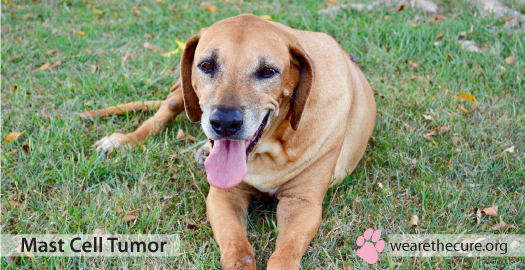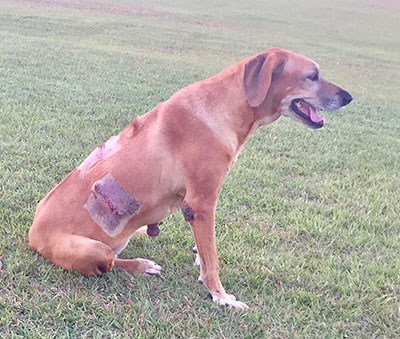Learning that your precious pet has a form of cancer can be overwhelming. For many of us, our dogs are a much-loved member of our family. Sadly the statistics are not encouraging as they suggest that one out of every three dogs will get cancer. Luckily, a drug called Stelfonta recently received F.D.A. approval and has shown highly promising results in treating Mast Cell Tumors in dogs.
No one wants our dogs to have mast cell tumors, so let’s become informed about this particular type of cancer and how Stelfonta could be a savior mast cell tumor dog treatment.

What is a Mast Cell Tumor?
Mast Cell tumors (MCT) are the cancer of a type of blood cell and they are the most common malignant skin tumor in dogs, although they can also affect other areas in the body. As much as 20% of skin masses in dogs could be MCTs. They can range in severity from very low-grade tumors to more ominous higher-grade tumors that are more likely to spread or metastasize.
Stelfonta Treatment Adds Another Option in the Fight Against MCT’s
Stelfonta is used to treat non-metastatic skin-based (cutaneous) mast cell tumors in dogs. That is, treatment for tumors when cancer has not spread from the primary site. Additionally, tumors must be less than or equal to, 10 cm3 in volume. Stelfonta is administered via intratumoral injection. The medicine is most helpful for Mast Cell Tumor treatment in dogs with MCT’s that are not suitable for surgery and have not yet spread to other parts of the body.
Tigilanol tiglate, derived from the fruit of the tropical blushwood tree in Australia, is the active substance in Stelfonta. Tigilanol tiglate stimulates the action of protein kinase C enzymes. When these enzymes are activated, they interrupt the blood supply to cells, resulting in those cells’ death. Additionally, the drug also activates the body’s immune system to promote wound healing.
This cancer veterinary medicine has shown very promising results in treating dogs with Mast Cell Tumors in the skin or the tissues just under the skin. Following studies in 2014, Chad Johannes, D.V.M., DACVIM (SAIM, Oncology), one of the study authors, said, “To have such a high response rate for a cancer drug is not common.”
Stelfonta Statistics
Virbac, a global animal health company that has launched the Stelfonta product, has stated the following:
- 75% of mast cell tumors achieved resolution of the target tumor with just one treatment
- 88% of dogs achieve the target tumour’s resolution 28 days after either the first or 28 days after a second treatment.
- 12 weeks after a single injection, 96% of dogs remained disease-free at the site of the treated tumor
- In 98.2% of cases, complete healing was observed within three months
- Most wounds were re-epithelialized entirely within 28 to 42 days of treatment, with good cosmetic outcomes
- The treatment is generally well-tolerated and does not adversely affect the quality of life
Stelfonta is available only by prescription due to the professional expertise required to diagnose MCTs and properly administer it. Additionally, there are instructions for post-treatment care and monitoring the product’s safe use, including treating any adverse reactions.
Possible Side Effects:
The most common adverse reactions associated with Stelfonta are wound formation at the tumor site and injection site reactions, such as pain, swelling, reddening of the skin, bruising, thickening, scarring, and some cells’ death in the tissues. In some dogs, there was lameness in the treated leg. Vomiting, diarrhea, hypoproteinemia, and hypoalbuminemia also occurred.
Learning More About Dogs with Mast Cell Tumors
What Causes Mast Cell Tumors in Dogs?
There is no easy answer to what may cause MCT in dogs. The exact cause is not yet known but it’s believed that the development of MCTs may be the result of a combination of factors, most of which are beyond the control of owners, such as hereditary or environmental factors. It is widely believed that there are genetic mutations that could be involved in MCTs.
Do MCTs Affect all Breeds of Dogs?
Some breeds are pre-disposed to MCTs suggesting that owners of these varieties should be on the look-out for any unusual masses or lumps all the time. The breeds that may be more susceptible are: Beagles,Shar Peis, Boston Terriers, English Bulldogs, Pugs, Labrador, Cocker Spaniels, Schnauzers, Staffordshire Bull Terriers, Rhodesian Ridgebacks, Golden Retrievers, Weimaraners and Boxers. Although these breeds may have the highest incidence, any dog breed can develop such tumors.
There is also some evidence to suggest that overweight dogs are more likely to develop MCTs as is the case with many other health conditions. Therefore, it is recommended to keep your pet at a healthy weight with a healthy diet and exercise to aid in preventing mast cell tumors in dogs.

Symptoms of Mast Cell Tumors
This is where it gets tricky! Symptoms can differ. Sometimes the only symptom may be a mass or lump, while in other cases the mast cells may cause other symptoms if they release histamine such as: vomiting, diarrhea, skin redness, swelling or loss of appetite.
If, unfortunately, the cancer has reached an advanced stage, and has already spread to other organs then dogs with mast cell tumors may also suffer from internal hemorrhage or fluid accumulation. If advanced to this end stage, symptoms of Mast Cell Tumors in dogs could include depression and lethargy, pale gums, or even rapid breathing.
Early Detection is Key for MCT in Dogs
Stelfonta is a recommended treatment for cancer that has not spread from the primary site, therefore early detection is vital.
Regular checks could be crucial in identifying any unusual masses or lumps. Vets recommend running your hands over your pet’s body, feeling for any irregularities on the surface of the skin. Also, visually check all areas from their face to the underside of their paws. Additionally, note any change in fur direction or any unusual swelling or redness. These are often signs in dogs with mast cell tumors.
The National Canine Cancer Foundation has developed a useful guide, based on Vets’ valuable input, outlining how to “Check Your Dog”. A good way to remember to check is to have a specific date like the 14th of every month.
Experts agree that older pets are more at risk for MCTs. If your dog is older or one of the susceptible breeds, you should be even more attentive to the possible symptoms. The discovery of early warning signs should prompt a trip to the Vet for a quick diagnosis and a treatment plan.
The success of Stelfonta may increase the life expectancy of dogs with mast cell tumors. That means dogs with mast cell tumors can still live a long and happy life in many cases!
Links to related information:
Canine Cancer Library: Mast Cell Cancer



My dog has just undergone a mass cell tumour removal and taisal removal . Reading about your beautiful dogs recovery is what I needed . He is 10.5 and I was worried but we are 2 days post op and he is eating and wagging his little stump. So I am hopeful
Why aren’t vets talking about this in Australia?
My dog had a very invasive mast cell tumor surgery earlier this year. She recovered super fast and we got on with life.
Last week her thigh looked bigger so I monitored it and took her to the vet today.
Yay happy new year your dog’s tumor is back in the same area and it doesn’t look good.
Other than go get radiation and or chemo which would make her life hell nothing was offered besides antihistamines or that dreadful prednisone which I said no to after seeing what it did to my previous dog.
So now I can just try and make her life as best I can with the antihistamines and keep up her homeopathic remedies because I won’t give up on her until she decides she’s had enough.
STELFONTA is available in Australia. Annoyingly, not all veterinarians are offering it yet, but it’s worth finding a vet who does. I’m so sorry your dog is going through this.